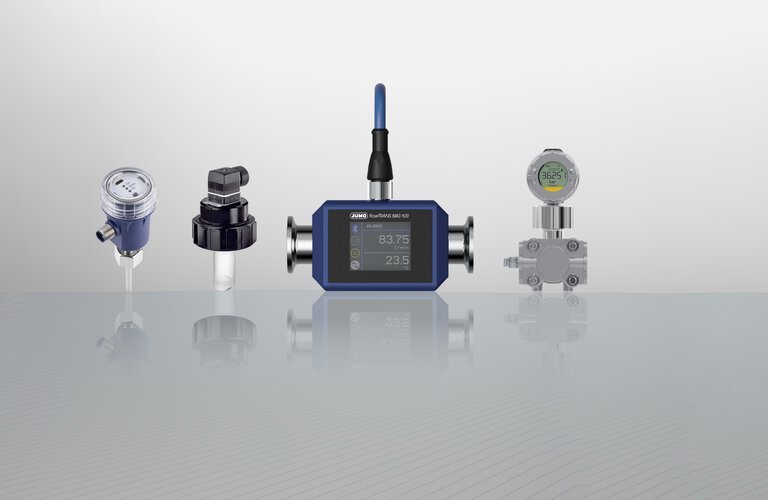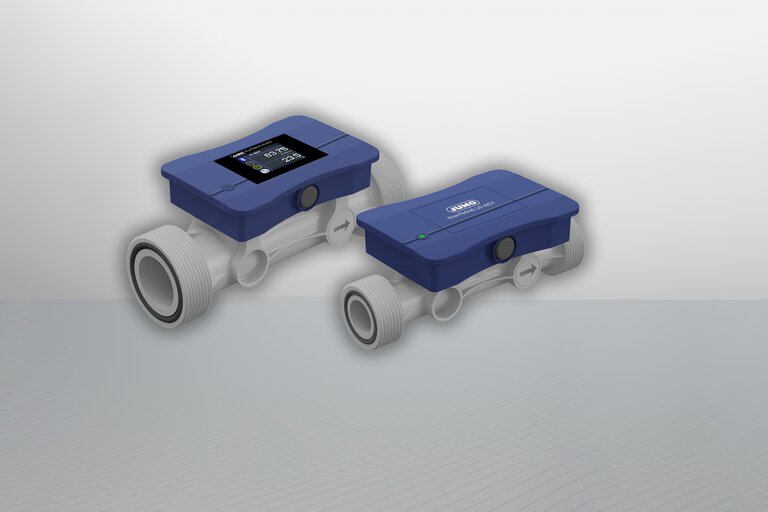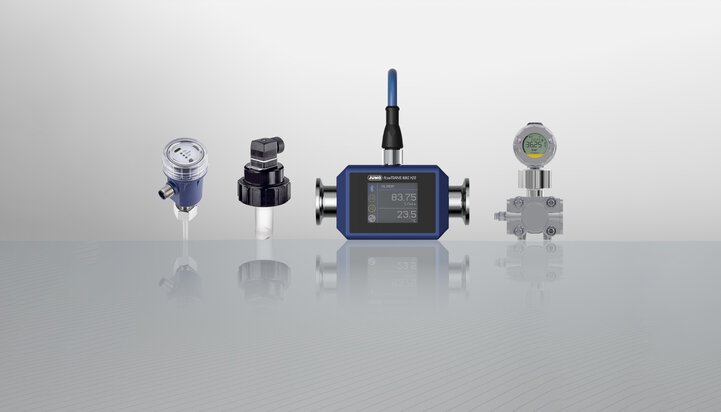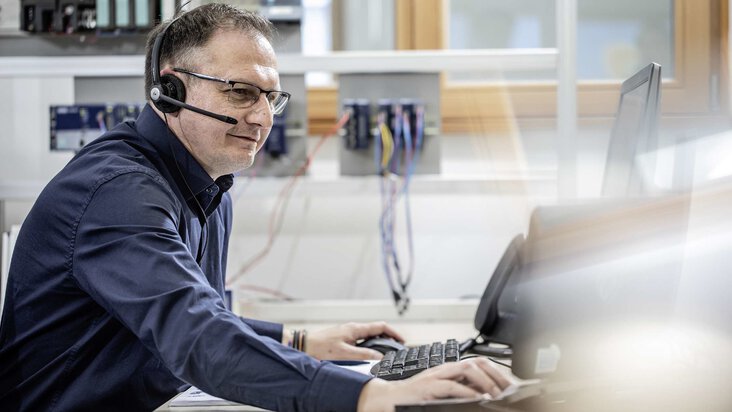
Flow measurement - What you should know
Along with temperature and pressure measurement, flow measurement is one of the most important tasks in industrial measurement technology. In principle, the physical measurand flow can probably be determined with most measurement methods. In practice, the selection of the measurement method depends on the respective application. Find out more about the individual flow measurement methods and make the selection of suitable flow sensors easier!
Table of contents
How do you define the measurand flow?
Flow measurement determines the amount per time unit that flows through a pipe system. The medium can be a liquid, a gas, or steam. In flow measurement, a distinction is made between volumetric flow measurement and mass flow measurement.
Volumetric flow
The volumetric flow is a volume that flows through a pipe per time unit (in l/h, cfm, etc.). Most of the systems presented here measure volumetric flow.
Mass flow
Mass flow is defined as the mass that flows through a system per time unit (in kg/h, t/h, etc.). If the density of a medium is constant, the mass flow can be determined by multiplying the volume flow by the density. If the density is not constant – as is often the case with steam and gases – then it must also be measured with measurement technology.
In which applications does the flow need to be measured?
In many applications, the only requirement is to detect whether a minimum flow of a medium is occurring. The use of flow monitors is then required to provide such things as dry-running protection for pumps.
However, the sensor technology presented here is used for continuous flow measurement and is used in such applications as:
- Filling end products into bottles, containers, or tanks
- Monitoring or displaying the totalized flow rate in different processes
- In legal-for-trade systems such as fuel pumps or hot and cold water meters, etc.
What are the requirements for flow measurement?
The requirements for the flowmeter vary greatly depending on the measurement task. Good repeatability is required for filling. In legal-for-trade systems a type examination certificate is necessary (at least in the EU). Similarly, for monitoring and displaying the totalized flow rate in the process, any number of requirements exist that are related to a specific application or industry. These result, among other things, from the type of medium to be measured and the accuracy requirements, but also from legal obligations such as the Pressure Equipment Directive in the EU or explosion protection according to the ATEX directive.
Which media does a flow sensor measure?
The media is divided into 4 different categories, for which only selected sensor technology can then be used:
- Conductive liquids (>20 μS/cm): acids, bases, beer, milk, drinking water, etc.
- Non-conductive liquids: alcohols, glycols, mineral oil-based liquids, deionized water, etc.
- Gases: oxygen, nitrogen, compressed air, natural gas, etc.
- Steam: saturated steam, overheated steam
What are the measurement methods for flow measurement?
Flowmeters work according to different measuring principles, but each of them cannot measure all media of the previously indicated categories. The following table lists the common measurement methods and shows which liquid categories can be measured with them.
|
|
|
|
|
|
|
|
|
| Conductive liquid | |||||||
| Liquid | |||||||
| Gas | |||||||
| Steam |
Green = standard; Orange = use caution; Red = not possible or recommended
The table only allows the exclusion of a measuring principle for the respective liquid category. In the video and the following descriptions you will find more detailed information on the individual measurement methods.
Coriolis flow measurement
The rather complex and very expensive flowmeters based on the Coriolis principle have a unique selling point compared to all other principles presented here. You can determine the mass flow (kg/h, t/h, etc.) even if the density is not constant.
For example, Coriolis flowmeters contain a pipe that is constantly oscillated by an exciter. If no flow occurs, the measuring pipe oscillates back and forth evenly over the entire length. If a flow takes place, the inertia of the measurement medium results in a rocking motion along the pipe in the form of a wave. The sections at the beginning and end of the pipe then oscillate in different directions at the same time (i.e. with a phase shift). The phase shift ϕ is measured – it is a direct measure of the flow
v ~ φ.
If the pipe is filled with a heavier medium it vibrates at a lower frequency. Hence, the frequency is a measure for the density of the measurement medium. Through the flow and density, the flowmeters determine the mass flow.
Coriolis flowmeters are considered the most accurate inline flowmeters on the market, with specifications starting at 0.05 % of the measured value.
| Coriolis flowmeter | |
|---|---|
| Advantages | High degree of accuracy, determination of mass flow, no inlet and outlet sections |
| Disadvantages | Very high cost, pressure loss, sensitive reaction to gas bubbles in liquid media |
Electromagnetic flow measurement
An electromagnetic flowmeter (EMF) measures according to Faraday's law of electromagnetic induction. It consists of a metal measuring pipe through which the conductive measurement medium flows. Coils generate a magnetic field which is guided through the medium orthogonally to the flow direction.
A voltage is induced as soon as the conductive liquid moves through the orthogonal magnetic field. The induced voltage is measured via electrodes which are arranged at a 90° angle to the liquid and the magnetic field (right-hand rule).
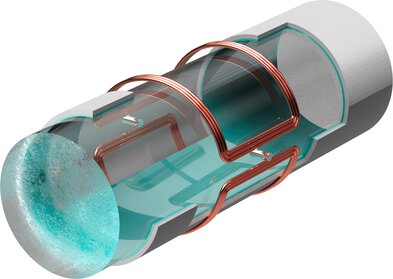
Electromagnetic flowmeter
The induced voltage is proportional to the flow velocity.
v ~ Uind
| Electromagnetic flowmeters | |
|---|---|
| Advantages | High level of accuracy, no pressure loss, no/low inlet and outlet sections, flexible application possibilities |
| Disadvantages | High costs, only for conductive media |
Ultrasonic flow measurement
For the ultrasonic flow measurement, 2 different physical principles are mainly used: the transit time principle and the Doppler principle. The market is dominated by the transit time principle described here.
Ultrasound is a mechanical or acoustic wave that is decelerated against the current and accelerated with the current. For flow measurements with ultrasound, the different transit times (with and against the current) are measured for the same section. The difference between the 2 times is the measure of the flow velocity.
V ~ △ t
In order to measure the time difference, 2 transducers are needed, which serve as "loudspeaker" and "microphone".
| Ultrasonic flowmeters | |
|---|---|
| Advantages | Accuracy, low pressure drop (depends on mechanical implementation of pipe/transducer), short inlet and outlet sections |
| Disadvantages | Measurement only possible up to a maximum content of gas bubbles and solids, no measurement of media with very high viscosity |
Vortex flow measurement
The vortex measuring principle is based on the Kármán vortex street, in which a body with a flow around it causes counter-rotating vortices to occur. In practice, vortices are created in the flowing medium by introducing an obstruction into the pipe. The vortices are counter-rotating and are alternately detached from the obstruction on the left and right side. The vortices form local pressure differences behind the obstruction, which are acquired by an appropriately designed sensor. The sensor measures the number of vortices per time unit (i.e. the frequency of the vortices that occur). The frequency is proportional to the flow velocity.
v ~ ƒ
| Vortex flowmeters | |
|---|---|
| Advantages | Possible for liquids, gases + steam, high pressures + temperatures, cost-effective variants available |
| Disadvantages | Only water-like viscosities possible, no "low flow" applications |
Calorimetric flow measurement
The method uses 2 resistance sensors, 1 of which is used as a heating element and the other as a sensing element for the medium temperature. The temperature difference between the heating Pt100 and the medium is kept constant and the heat output required for this is measured. The higher the flow of the medium, the more heat output is required to keep the temperature difference constant. This way, conclusions can be drawn about the respective totalized flow rate through the heat output.
The supplied power is a measure of the flow velocity:
v ~ P

Calorimetric flowmeter
| Calorimetric flowmeter | |
|---|---|
| Advantages | Cost-effective sensor technology for gas + liquid, leakage measurements possible |
| Disadvantages | Adhering pollutants/moisture (with gas) influence measurement, accuracy with "low-cost" solutions rather low, measurement result depends on medium |
Flow measurement with differential pressure/primary element
Primary elements include orifice plates, pitot tubes, or Venturi tubes. Installed in the pipe, they generate a differential pressure, which is measured, for example, in the orifice plate via the static pressure upstream and downstream of the orifice plate. The flow velocity can be determined from the differential pressure according to Bernoulli's equation; it is proportional to the square root of the differential pressure:
v ~ √△p
Appropriate differential pressure sensors are required to measure the differential pressure. The accuracy is thereby composed of the uncertainty of the primary element and the differential pressure transmitter.

Primary element
| Primary element | |
|---|---|
| Advantages | High temperatures + pressures possible due to mechanical flexibility of the primary element, for gas, liquid + steam |
| Disadvantages | limited measuring dynamics due to ratio of minimum and maximum flow (1:5 to 1:7), unfavorable accuracy/cost ratio for small diameters |
Paddlewheel flow measurement
The paddlewheel is rotated by the flow of the medium and an inductive pulse generator attached to the housing emits one pulse per paddlewheel that is passing by. Pulse frequency is a direct measure of flow velocity:
v ~ ƒ
Many paddlewheel sensors emit the pulse signal directly and an evaluation unit determines the flow from it. Alternatively, the sensors can also be equipped with electronic components that convert the pulse signal into an analog signal and feed it to the evaluation unit.

Paddlewheel flow sensor
| Paddlewheel flowmeters | |
|---|---|
| Advantages | Cost-effective design types available, flexible use of materials enables measurement of corrosive media |
| Disadvantages | Low flow application only possible to a limited extent due to start-up friction, the system is not wear-free due to the moving parts |
How do you choose the right sensor for the flow measurement?
The measuring principle must be suitable for the medium – as described above. Other requirements that a flow device must meet include:
- Operating conditions (flow range, pressure, temperature, material compatibility)
- Installation conditions (inlet/outlet sections, pipe routing, installation)
- Environmental influences (temperature, moisture, vibrations)
- Legal requirements (explosion protection, calibration obligation)
The choice is further complicated by broader practical constraints:
- Solid or gas content
- Non-optimal installation situation
- Cost versus accuracy
Due to these different challenges, expert consulting on the choice of flowmeter is essential.
- ${title}${badge}
